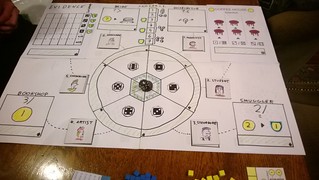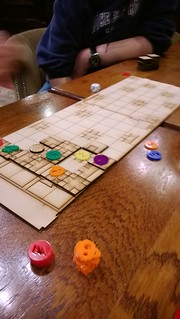2013 has been a lot less momentous than last year, no major purchases or moves. We've been adapting to life as a family and trying to make do with very poor nights' sleep (bless her, The Daughter seems to be one of the worst sleepers of her cohort of friends). It's been an excellent year, as The Daughter grows up we've got to watch her learn to smile, crawl, walk and start to talk. We're starting to meet the person too, as her personality develops. She's a very happy, giggly and affectionate girl and brings us both a lot of pleasure - which more than makes up for the nights.
Professionally, my employer (that I'm working for for the third time) that I've been employed by for half my working life was bought by a large American corporation which meant, predictably, a slight increase in bureaucracy, countered by an nice increase in benefits. I got to visit Minneapolis for work in June, my first visit to the mid-west US, and while there hooked up with a few gamers via BGG (who thankfully weren't axe-murderers) and went to the Fantasy Flight Games Event Centre for some after work gaming.
The year is ending on a strange note though, as I've come home from Bristol on my own, with The Wife and The Daughter remaining in Bristol for three weeks while I get radiotherapy for an over-active thyroid. It's strange having the house to myself - very quiet and lonely.
Games Design
I spent most of the year pressing on with Codename: Vacuum, racking up one or more plays per week, tweaking things here and there. It's getting better, slowly, but with so many cards each tweak needs careful balancing to ensure the decks are all roughly as good as each other.
In August, Dan Howard and I started up Newcastle Playtest, a bi-monthly meetup in a pub to playtest each other's games. It started off strongly with six designers getting involved, and plenty of willing playtesters. Nearer to Christmas it has died down a bit, it'll be interesting to see if there's enough interest in the New Year to keep it going. I've found it very useful, interesting and enjoyable on the occasions when I've managed to make it along.
In November, I decided to get in on the NaGa DeMon action and resurrected Codename: Proteome with a new theme and new mechanics as a game of Zombie science: Zombology. I managed to make five different prototypes, six different rulebooks and played it 16 times in the month of November. The end of the month version is available print-and-play and I'm still continuing to work on it.
After the hectic month of NaGa DeMon action, and with Christmas and its associated socialising on the cards, I had a fairly quiet December, no prototyping, hardly any playtesting and not much gaming at all until the Christmas break. I did have another game idea though: Codename: Dragon - a 2-player card game about St. George and the Dragon. It's been a long time since I last had three designs on the go.
General Gaming
I've had an un-written goal for the last five or so years to play as many games as there are days in the year. I've not managed it since 2010, but I've done it again in 2013: 370 + whatever I play at tonight's bonus Games Night. Again, I've counted iPad games against real opponents. My five and dimes were:
- 56: Codename: Vacuum - played this a lot!
- 27: 6 Nimmt! - a favourite Games Night filler
- 22: 7 Wonders - popular at Games Night and with the in-laws
- 19: Ra - mostly on the iPad while travelling for work
- 18 Race for the Galaxy - popular at Games Night and with The Wife
- 18: Zombology - almost all in November!
- 14: Incan Gold - popular at Games Night
- 13: Hol's der Geier - a Games Night filler
- 11: Carcassonne - On the iPad and with the in-laws
- 11: No Thanks! - Games Night filler
- 11: X-Wing Minis - need to play this more!
- 10: Thunderstone - popular with The Wife and the in-laws
- 9: The Resistance - at Games Night, and when Paul came to visit
- 8: Coloretto - Games Night I guess?
- 8: For Sale - another short game popular at Games Night
- 8: Hanabi - love this one, only got it in July I think
- 7: 11 Nimmt! - Games Night filler
- 6: Hey! That's My Fish! - on the iPad while travelling
- 6: The Speicherstadt - I taught this a couple of times at Newcastle Gamers
- 5: Carcassonne: The Castle - on holiday with the sister-in-law
- 5: Lords of Waterdeep - a Games Night favourite
- 5: Love Letter - learnt this at Beer and Pretzels
I also made it to a convention this year, for the first time in about 4 years: Beer and Pretzels in Burton-on-Trent in May. It was a great weekend, hanging out with my friend Terry whose Games Night I used to attend when we lived down south. I learnt several new games that weekend too.
Purchases-wise, I bought The Bridges of Shangri-La in the Travelling Man sale and Hanabi and Love Letter later in the year. I got Macao, Thurn and Taxis and Alea Iacta Est for my birthday and Coup and Galaxy Trucker for Christmas. Plus I got a boatload of X-Wing minis during the year. I also got rid of Babel, Canal Mania, Clans, Eminent Domain, Fzzzt! and Meuterer - given away to friends in the hope they get played in their new homes.
Blogging
My goals for blogging for the year were to blog on at least 45 of the Mondays in 2013 and get 20,000 page views and a few extra followers. As it turns out I've blogged every Monday in 2013 (plus a bunch of extra times in November for NaGa DeMon), got 35,000 page views and 7 new followers. A huge success. Mostly down to NaGa DeMon if I'm honest. My most popular posts this year were:
- My thoughts on KickStarting games
- Excitement building about Newcastle Playtest
- A discussion of how my games/life balance has changed over the years
- A mention of doing some Windows Phone development
- The rules to a game I ran to encourage NaGa DeMon feedback
I hope you all had good years too, and here's hoping next year will be even better!







